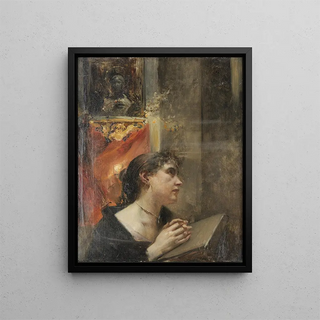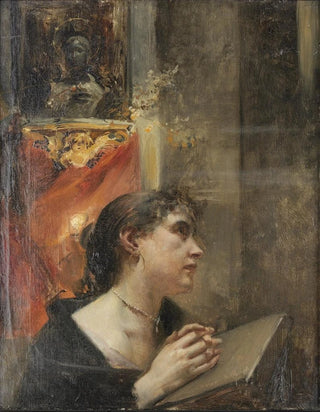Painting La dévotion dans l'église - Eduard Veith | Art print Source: Tableau La dévotion dans l'église - Eduard Veith | Reproduction


View from behind

Frame (optional)
In the vast panorama of art history, some works manage to capture the very essence of humanity, transcending the simple framework of painting to touch on spirituality and emotion. "The Devotion in the Church" by Eduard Veith is undoubtedly one of these creations. This piece, imbued with serenity and reverence, invites us to enter a sacred space where faith and art meet. At the heart of this depiction, the artist immerses us in an atmosphere of contemplation, where every detail seems to whisper profound truths about the human condition. The soft light filtering through the stained glass, the peaceful faces of the faithful—everything contributes to creating a living tableau that resonates with our spiritual quest.
Style and uniqueness of the work
Eduard Veith, master of realism, manages to infuse "The Devotion in the Church" with rare emotional depth. His style, characterized by meticulous attention to detail and a carefully chosen color palette, brings this scene of devotion to life. The textures of the garments, the reflections of light on surfaces, as well as the expressions of the characters—these are all elements that testify to his technical skill. The composition, balanced and harmonious, guides the viewer’s gaze through the space, creating a sensation of total immersion. Each character, although frozen in time, seems to carry a story, a prayer, or a thought, making the work all the more poignant. This painting does not merely depict a religious scene; it evokes a feeling of belonging to something greater, almost sacred.
The artist and his influence
Eduard Veith, a German-born artist, left his mark on his era through his unique approach to religious painting. Influenced by the great masters of the past, he reinterpreted classical themes with a contemporary perspective. His ability to capture the psychological depth of his subjects earned him a prominent place in the art world. Veith does not simply depict scenes of devotion; he imbues them with a human dimension.

Matte finish

View from behind

Frame (optional)
In the vast panorama of art history, some works manage to capture the very essence of humanity, transcending the simple framework of painting to touch on spirituality and emotion. "The Devotion in the Church" by Eduard Veith is undoubtedly one of these creations. This piece, imbued with serenity and reverence, invites us to enter a sacred space where faith and art meet. At the heart of this depiction, the artist immerses us in an atmosphere of contemplation, where every detail seems to whisper profound truths about the human condition. The soft light filtering through the stained glass, the peaceful faces of the faithful—everything contributes to creating a living tableau that resonates with our spiritual quest.
Style and uniqueness of the work
Eduard Veith, master of realism, manages to infuse "The Devotion in the Church" with rare emotional depth. His style, characterized by meticulous attention to detail and a carefully chosen color palette, brings this scene of devotion to life. The textures of the garments, the reflections of light on surfaces, as well as the expressions of the characters—these are all elements that testify to his technical skill. The composition, balanced and harmonious, guides the viewer’s gaze through the space, creating a sensation of total immersion. Each character, although frozen in time, seems to carry a story, a prayer, or a thought, making the work all the more poignant. This painting does not merely depict a religious scene; it evokes a feeling of belonging to something greater, almost sacred.
The artist and his influence
Eduard Veith, a German-born artist, left his mark on his era through his unique approach to religious painting. Influenced by the great masters of the past, he reinterpreted classical themes with a contemporary perspective. His ability to capture the psychological depth of his subjects earned him a prominent place in the art world. Veith does not simply depict scenes of devotion; he imbues them with a human dimension.






